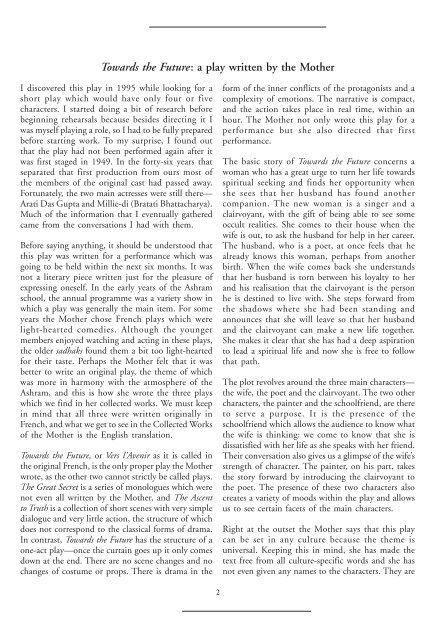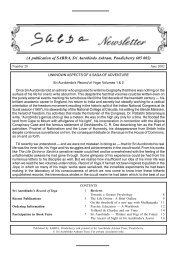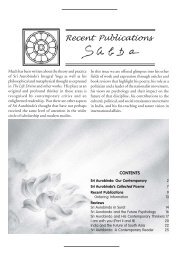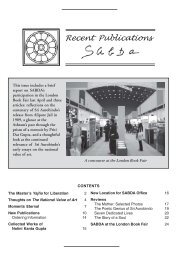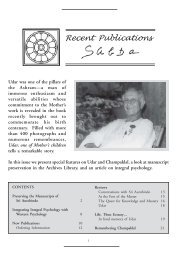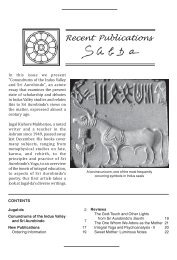November 2010 - Sabda - Sri Aurobindo Ashram
November 2010 - Sabda - Sri Aurobindo Ashram
November 2010 - Sabda - Sri Aurobindo Ashram
Create successful ePaper yourself
Turn your PDF publications into a flip-book with our unique Google optimized e-Paper software.
Towards the Future : a play written by the Mother<br />
I discovered this play in 1995 while looking for a<br />
short play which would have only four or five<br />
characters. I started doing a bit of research before<br />
beginning rehearsals because besides directing it I<br />
was myself playing a role, so I had to be fully prepared<br />
before starting work. To my surprise, I found out<br />
that the play had not been performed again after it<br />
was first staged in 1949. In the forty-six years that<br />
separated that first production from ours most of<br />
the members of the original cast had passed away.<br />
Fortunately, the two main actresses were still there—<br />
Arati Das Gupta and Millie-di (Bratati Bhattacharya).<br />
Much of the information that I eventually gathered<br />
came from the conversations I had with them.<br />
Before saying anything, it should be understood that<br />
this play was written for a performance which was<br />
going to be held within the next six months. It was<br />
not a literary piece written just for the pleasure of<br />
expressing oneself. In the early years of the <strong>Ashram</strong><br />
school, the annual programme was a variety show in<br />
which a play was generally the main item. For some<br />
years the Mother chose French plays which were<br />
light-hearted comedies. Although the younger<br />
members enjoyed watching and acting in these plays,<br />
the older sadhaks found them a bit too light-hearted<br />
for their taste. Perhaps the Mother felt that it was<br />
better to write an original play, the theme of which<br />
was more in harmony with the atmosphere of the<br />
<strong>Ashram</strong>, and this is how she wrote the three plays<br />
which we find in her collected works. We must keep<br />
in mind that all three were written originally in<br />
French, and what we get to see in the Collected Works<br />
of the Mother is the English translation.<br />
Towards the Future, or Vers l’Avenir as it is called in<br />
the original French, is the only proper play the Mother<br />
wrote, as the other two cannot strictly be called plays.<br />
The Great Secret is a series of monologues which were<br />
not even all written by the Mother, and The Ascent<br />
to Truth is a collection of short scenes with very simple<br />
dialogue and very little action, the structure of which<br />
does not correspond to the classical forms of drama.<br />
In contrast, Towards the Future has the structure of a<br />
one-act play—once the curtain goes up it only comes<br />
down at the end. There are no scene changes and no<br />
changes of costume or props. There is drama in the<br />
form of the inner conflicts of the protagonists and a<br />
complexity of emotions. The narrative is compact,<br />
and the action takes place in real time, within an<br />
hour. The Mother not only wrote this play for a<br />
performance but she also directed that first<br />
performance.<br />
The basic story of Towards the Future concerns a<br />
woman who has a great urge to turn her life towards<br />
spiritual seeking and finds her opportunity when<br />
she sees that her husband has found another<br />
companion. The new woman is a singer and a<br />
clairvoyant, with the gift of being able to see some<br />
occult realities. She comes to their house when the<br />
wife is out, to ask the husband for help in her career.<br />
The husband, who is a poet, at once feels that he<br />
already knows this woman, perhaps from another<br />
birth. When the wife comes back she understands<br />
that her husband is torn between his loyalty to her<br />
and his realisation that the clairvoyant is the person<br />
he is destined to live with. She steps forward from<br />
the shadows where she had been standing and<br />
announces that she will leave so that her husband<br />
and the clairvoyant can make a new life together.<br />
She makes it clear that she has had a deep aspiration<br />
to lead a spiritual life and now she is free to follow<br />
that path.<br />
The plot revolves around the three main characters—<br />
the wife, the poet and the clairvoyant. The two other<br />
characters, the painter and the schoolfriend, are there<br />
to serve a purpose. It is the presence of the<br />
schoolfriend which allows the audience to know what<br />
the wife is thinking: we come to know that she is<br />
dissatisfied with her life as she speaks with her friend.<br />
Their conversation also gives us a glimpse of the wife’s<br />
strength of character. The painter, on his part, takes<br />
the story forward by introducing the clairvoyant to<br />
the poet. The presence of these two characters also<br />
creates a variety of moods within the play and allows<br />
us to see certain facets of the main characters.<br />
Right at the outset the Mother says that this play<br />
can be set in any culture because the theme is<br />
universal. Keeping this in mind, she has made the<br />
text free from all culture-specific words and she has<br />
not even given any names to the characters. They are<br />
2


